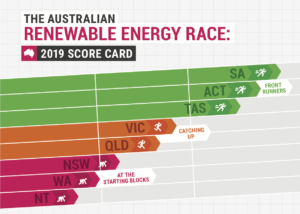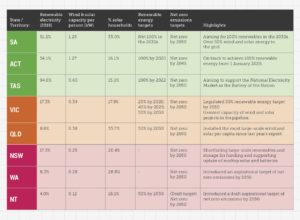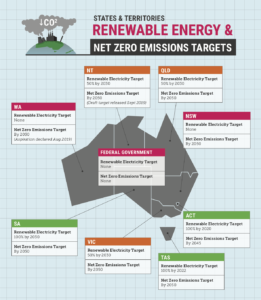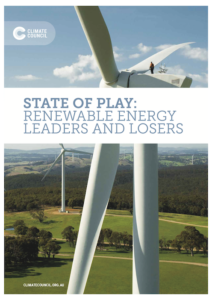This content is more than 4 years old
States and territories are leading the transition to renewable energy in Australia, as the Federal Government not only fails to lead but obstructs progress.
State of Play: Renewable Energy Leaders and Losers tracks the relative progress of Australian states and territories based on their performance across a range of renewable energy metrics: share of electricity from renewable energy; proportion of households with rooftop solar; large-scale wind and solar capacity per capita; and targets or policies in place to support the transition.
Key Findings:
South Australia has won this year’s state and territory renewables race, with the ACT and Tasmania hot on its heels.
- South Australia, the ACT and Tasmania are way ahead of the other states and territories across a range of renewable energy metrics. These include share of renewable energy, wind and solar capacity per capita, and policies in place to support the transition to renewable energy.
- South Australia is a global leader in transitioning to a grid with a high share of wind and solar PV energy. The state now generates over half of its electricity from wind and solar, and is aiming for net 100% renewable energy in the 2030s.
- The ACT is on track to achieve 100% renewable energy from 1 January 2020. This is a remarkable achievement and makes the ACT just the eighth jurisdiction in the world with a population above 100,000 – and the only one outside of Europe – to achieve 100% renewable electricity.
- Tasmania’s Battery of the Nation plan could double Tasmania’s renewable energy capacity and generate local jobs and billions of dollars in investment.
Victoria and Queensland are making good progress on the transition to renewable energy, but will need to work hard to catch the frontrunners.
- Victoria wins the ‘Rising Star Award’ for having the most substantial capacity of large-scale wind and solar projects in the pipeline of any state or territory.
- Queensland wins the ‘Most Improved Award’ for eclipsing the other states and territories in terms of increased large-scale wind and solar capacity per person from last year’s report. Nearly half of the large-scale renewable energy projects completed across Australia in 2018 were in Queensland.
- Despite progress, Queensland is not on track to meet its target of 50% renewable energy by 2030.
- The Queensland Government continues to support new fossil fuel developments in the state, which is fundamentally at odds with action on climate change.
New South Wales and Western Australia are the only states without a renewable energy target, while the Northern Territory ranks last or near the bottom on most other metrics.
- The Northern Territory wins the Wooden Spoon for finishing last in this year’s renewables race, as it has in every scorecard to date. However, recent signals from the NT government are encouraging.
- The Northern Territory recently announced a draft aspirational target for net zero emissions by 2050, making it the last state or territory to release a net zero target. While this is an important step in the right direction, the draft plan includes expansion of the Territory’s gas industry, which is incompatible with emissions reduction.
- Like the NT, WA’s Government is supporting gas developments, while the NSW Government continues its vocal support for coal. There can be no new coal or gas projects whether for export or domestic use if Australia is to address intensifying climate change.
States and territories are driving the transition to a renewable future, in the face of the Federal Government’s reckless lack of leadership.
- Increasing global temperatures – driven primarily by greenhouse gas emissions from burning coal, oil and gas – are exacerbating extreme weather events in Australia and globally. Australians are enduring bushfire conditions, heatwaves and flooding made worse by climate change.
- To tackle climate change effectively, we must rapidly reduce our greenhouse gas emissions by accelerating the uptake of renewable energy and storage technologies. Emissions have been rising year-on-year for 5 years under the Federal Government. This is why leadership from states and territories is so crucial.
- If the Northern Territory’s draft target for net zero emissions is adopted, it will mean that all states and territories will have introduced targets for net zero emissions by 2050 at the latest. Australia will have a de facto target even in the absence of Federal Government leadership or policy.
- The Federal Government is not only failing to lead, it is getting in the way of state and territory leadership on renewable energy. As a result, several states and territories have declared the intention to go it alone on renewable energy policy. It is time for all states and territories to create their own forums for coordination and move on without the Federal Government.



